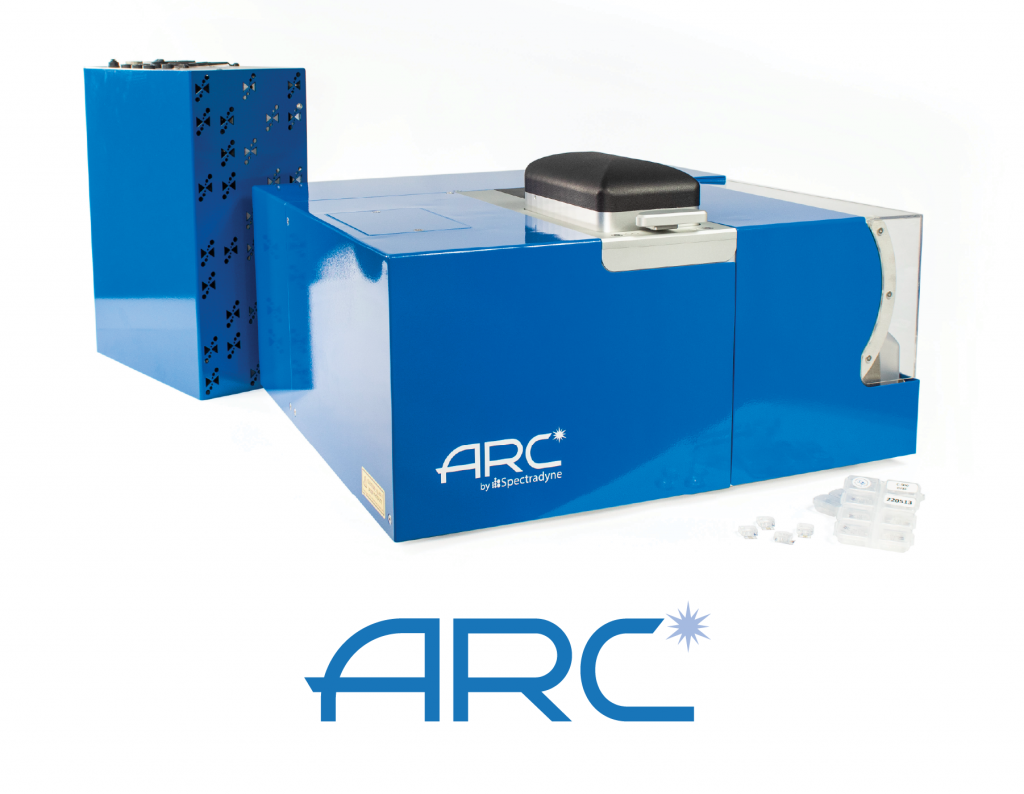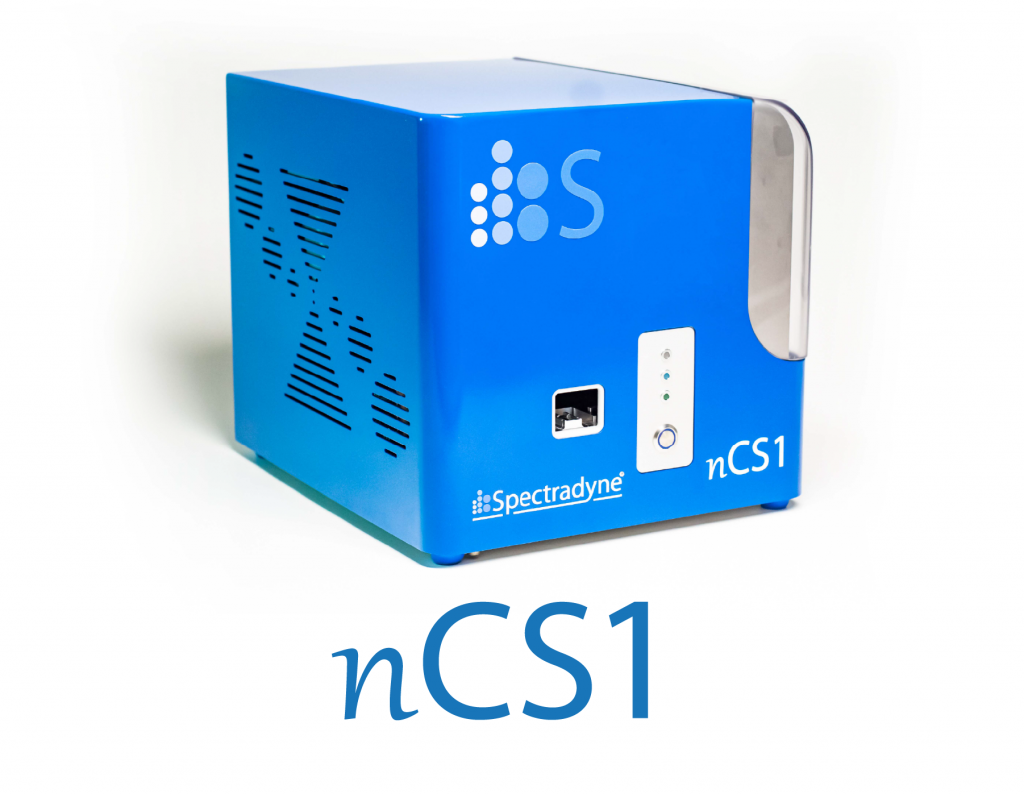Applications of Spectradyne’s Technology
Why Spectradyne?
The Spectradyne nCS1TM and ARCTM are the only benchtop technology that provides high-resolution size distributions and accurate concentration measurements for particles in the 50 nm — 10 μm diameter size range. These instruments, using only electronic sensing, rapidly count and sizes individual nanoparticles in a sample, achieving few-percent precision in both size and concentration on par with CryoTEM. Spectradyne’s nCS1 and ARC deliver unprecedented capabilities for analyzing nanoparticles of any type, yielding more accurate and representative results than any other method. These instruments thus provide an orthogonal technique to optically-based microparticle analysis instruments, while also enabling high-resolution analysis of a variety of biological and industrial particles.
Read our overview of the technology, check out our specifications, as well as our comparative head-to-head comparison with other technologies.
Watch a video presentation that gives an overview of Spectradyne’s technology.
Applications for our Nanoparticle Analyzers
Lipid Nanoparticles and Nanomedicine
Lipid nanoparticles and nanomedicines are nanoparticle-enabled therapeutics. At this size scale, the size and concentration of the nanoparticles themselves directly impact the performance of the overall product: Size determines payload capacity and diffusion rates, (e.g. bioavailability) and concentration represents the total amount of drug in the formulation, namely the dose. Size, concentration, and payload therefore represent three critical quality attributes that must be accurately measured to ensure safety and efficacy of nanoparticle-based therapeutics such as lipid nanoparticles and nanomedicine.
This means that the ability to precisely measure particle size distributions for liposomes and LNPs is of critical importance. Spectradyne’s nCS1TM delivers higher-resolution measurement of particle size when compared to optical techniques like dynamic light scattering (DLS) and nanoparticle tracking. At the same time, it also delivers industry-leading concentration measurements, which are also critical because concentration correlates directly to dosage.
Spectradyne’s ARCTM combines our microfluidic resistive pulse sensing (MRPS) with single-particle fluorescence detection (F-MRPS), allowing for accurate payload quantification, target ligand quantification, and encapsulation efficiency measurement together with particle size and concentration.
Read about measurements of LNPs using our technologies.
Extracellular vesicle analysis
Extracellular vesicles can be especially difficult to measure, in particular when attempting to use optical techniques, due to the poor index contrast these provide with water or other suspending fluids. The nCS1TM and ARCTM provide clear and strong signals even for vesicles down to 50 nm in diameter. Accurate quantification is critical for assessing the purity and biological activity of extracellular vesicles (EVs), and for understanding EV-mediated mechanisms of intercellular communication. EVs present very low optical contrast with their surrounding aqueous media however, so scatter light very weakly, and present an inherent difficulty for accurate quantification by any light scattering-based technique including Nanoparticle Tracking Analysis (NTA). Spectradyne’s nanoparticle analyzers use an electrical (non-optical) method for accurately counting and sizing individual EVs and agrees very well with TEM, the gold standard technique. In the ARC, this capability is combined with individual particle fluorescence phenotyping.
Learn how Spectradyne’s nCS1TM and ARCTM can help make sense of your EV data.
Read about our extracellular vesicle capabilities.
Virus
Viruses are biological nanoparticles that are used in a variety of applications. In addition to their well-known use in vaccines, viruses are being developed as therapeutics for disease, and serve as a convenient means to transfer genetic information. In many applications, an accurate measure of the concentration (titer) of the virus is required. This is difficult or impossible to do using conventional methods such as dynamic light scattering (DLS) and optical tracking, where the small size and low optical index contrast make detecting virus quite challenging. Furthermore, DLS does not give concentration information. Spectradyne’s nCS1TM and ARCTM can easily detect virus down to 50 nm in diameter, yielding accurate concentration data. In Spectradyne’s ARC, this capability is combined with individual particle fluorescence phenotyping.
Read about measurements of virus.
Gene therapy and nanomedicine
Viral and non-viral vectors for delivering therapeutics must be accurately quantified in any experiment to properly assess purity and biological activity and control for dosage. These particles cannot easily be quantified by optical techniques such as Dynamic Light Scattering (DLS) or Nanoparticle Tracking Analysis (NTA) however, since they scatter light weakly and are typically polydisperse is size. And often the samples aren’t available in large enough quantity for analysis using conventional techniques. Spectradyne’s nCS1TM and ARCTM use an electrical (non-optical) technology for quantifying nanoparticles that delivers high resolution concentration vs size distributions for samples with any degree of polydispersity-and only requires 3 microliters of sample for analysis. In the ARC, this capability is combined with individual particle fluorescence phenotyping. Find out how Spectradyne’s nCS1 and ARC can help you characterize your nanoparticle-mediated therapeutic.
Read about applications to gene therapy and nanomedicine.
Protein aggregation
Drug molecules and other ingredients in a failing formulation aggregate into particles that grow larger over time in a continuous process that results in a broad (polydisperse) particle size distribution. Detection of these aggregates is critical for ensuring the safety and efficacy of the product, and dramatic time and financial savings are realized by formulation scientists that detect these particles earlier in the formation process, when the aggregates are still small. Spectradyne’s nCS1TM and the fluorescence-capable ARCTM measure the concentration of particles in a formulation more accurately and at smaller sizes than any other technology available — these instruments enable researchers to quickly assess how a formulation responds to stress after just a few minutes instead of waiting days to see a measurable effect with other techniques.
Read about applications to protein aggregation.
“The nCS1 has rapidly become an indispensable tool for accurately quantifying EVs in my lab.”
Zoltan Varga, Hungarian Academy of Sciences
Industrial nanoparticles
Nanoparticles play important roles in many modern industrial materials including paints, inks, semiconductor material processing (e.g., polishing), cosmetics and even foods. The diverse physical properties of these materials present a challenge for many techniques, especially those relying on light scattering, which depends strongly on the optical properties of the materials. Even fractionation methods such as disc centrifugation and asymmetric flow field flow fractionation rely ultimately on optical detection and are not quantitative for concentration. Because it uses an electrical method to count and size nanoparticles one-by-one, Spectradyne’s nCS1 and ARC deliver accurate measurements of all material types — learn how it can help your industrial application here.
Read about our technology’s diverse materials capabilities.
Spectradyne’s nCS1TM and ARCTM versus DLS and NTA
Dynamic light scattering (DLS) and nanoparticle tracking analysis (NTA) both use light scattering to monitor particle Brownian motion, which combined with estimates of solution viscosity can be used to provide an estimate of the hydrodynamic radius of particles. These indirect methods are appealing because they only require probing a sample with light, requiring very little sample preparation. However, these methods are in fact prone to large systematic errors and both DLS and NTA can generate particle size distributions that are quite misleading and incorrect. Resistive pulse sensing as used by Spectradyne’s nCS1 and ARC instead measure the individual diameters of each particle, so the particle size histograms provide quantitative, high resolution measurements of both particle diameter and absolute concentration.
There are in fact direct comparisons of DLS and NTA to the gold standard measurement of individual particles by electron microscopy (EM), with comparisons in the published literature showing that both DLS and NTA present “false peaks” in their reported distributions that do not match the EM results.
Read about our head-to-head comparison with other technologies, our overview of the technology, and read our specifications.
Polydisperse samples
A polydisperse particle mixture is one in which the constituent particles vary in size, shape, or molecular weight. The size distribution in such mixtures can be difficult to ascertain; bulk optical properties of the mixture, such as opacity, do not give detailed information about the population distribution. This is especially true as particle sizes decrease into the deep sub-micron range. Typical characterization instrumentation, such as dynamic light scattering (DLS) and optical particle tracking cannot resolve highly polydisperse mixtures of particles. Spectradyne’s nCS1 and ARC can.
Read about our polydispersity capabilities.
Contamination
How clean is your IV saline? How well does your sub-micron filter work? These are questions we asked and answered using the nCS1TM. We looked at nanoparticles in an IV saline bag, and compared the results to those found in an IV flushing syringe. We also looked at how effective a sub-micron filter is in removing a range of particles from a sample containing a broad distribution of ferromagnetic nanoparticles. Interested in finding out what we found?
Read about our fluid cleanliness study here.

